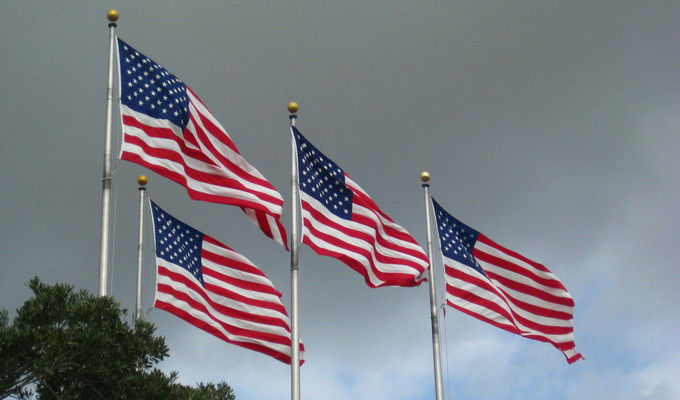National Flag of USA
For the Americans, the "Star-Spangled Banner" has a very special meaning. In hardly any other country is the national flag so revered and regarded with pride as in the USA. Let's dive into the story a little.
History of the National Flag of USA
During the War of Independence 1775 - 1783, the 13 colonies revolted against the British crown. From the "Sons of Liberty" flag, which first appeared in 1775, with its red and white horizontal stripes, the first official flag of the USA developed until the Declaration of Independence in 1776: the Grand Union Flag. It consisted of the Union Jack symbol (Union Jack = flag of the British Kingdom) in the upper left corner and 13 red and white stripes symbolizing the 13 founding states.

In 1777, at the 2nd Continental Congress the national flag of USA, which is also called the Betsy Ross flag, was decided: it should contain 13 red and 13 white stripes, as well as 13 stars. The stars should be white on a blue background. However, the arrangement of the stars has not yet been prescribed, so several variations have been in circulation during this time.

Soon 2 more states joined the Union, and the flag was expanded to 15 stripes and 15 stars. This is also the time when the national anthem of the USA was born. in 1813, Francis Scott Key composed the song "The Star Spangled Banner", which was declared a "National Anthem" in 1931.
In 1818 it was decided to leave the number of stripes at the original 13, but to change the stars for each new state.

In 1912 there was the first official arrangement for the stars. The last time the flag of usa was changed was in 1960, when Alaska and Hawaii joined the United States as the 49th and 50th states.
The meaning of the colors of the National Flag of the USA
The colours were based on the colours of the British Union Jack. Their symbolism in the star-spangled banner is: blue stands for vigilance and justice, white for purity and innocence and red for bravery and resilience.
USA Flag Law
Since 1942 there is the US Flag Law, which regulates the correct handling of the Star-Spangled Banner. It is of primary importance in the administration and in the army. In everyday civil life, it is hardly enforced, since prosecution would violate the law of freedom of expression.
Here is an excerpt of the rules:
- The national flag of USA should not be lowered before any person or object, except to salute the flag of a foreign ship or state.
- The national flag of USA should not become part of a costume or jersey. Exceptions are flags as patches on uniforms of the military, fire, police and patriotic organizations. On military uniforms, the flag is worn on the left upper arm.
- If the national flag of USA is lowered, it should not touch the ground or anything else. Also, the national flag of USA must be solemnly and neatly folded for storage
- When the national anthem of the USA is played, the Star-Spangled Banner should be greeted from the first to the last note standing. If the hymn is played without raising the national flag of USA, the source of the music should be greeted.
- On the death of a current or former US president, the flag should be raised at half-mast for the period of 30 days.

